![]()
Winter 2014 | ITIC
This study is originally published by The Meir Amit Intelligence and Terrorism Information Center. The study is an overall analysis of ISIS, also known as ISIL, Islamic State (or IS). The study is structured in nine sections,[1] which if read in conjunction with each other, draws a complete picture of ISIS. You can also download the study in PDF format here.
ISIS as an Islamic Salafist-jihadi organization
ISIS is a Salafist-jihadi Islamic organization, part of the Sunni Islamic extremist faction which seeks to restore early Islam’s days of glory through jihad, a holy war directed against internal and external enemies. The Salafist movement perceives the time of the Prophet Muhammad as ideal and the first Caliphs who succeeded him as role models (the Arabic word Salaf means ancestor or first generation). The modern Salafist movement began in Egypt, a result of the desire to purify Islam of its flaws and return to what was perceived as the Golden Age of Islam.
Initially, the Salafist movement focused on religious studies and the winning of hearts and minds (da‘wah) as a way of creating an Islamic society and a state ruled by Islamic law. However, within the Salafi movement an extremist faction called Salafiyya Jihadiyya (i.e., jihadi Salafism) developed, from which Al-Qaeda and the global jihad organizations, including ISIS, have emerged. An ideologically important contribution to the development of the movement was made by Sayyid Qutb (1906-1966), an Egyptian ideologue whose ideas inspired the establishment of Islamic organizations that supported violent struggle (including the Egyptian Islamic Jihad, led by Ayman al-Zawahiri, Bin Laden’s successor as leader of Al-Qaeda).
From a Salafist-jihadi perspective, Muslims must strive to disseminate and implement Islam in all areas of life by liberating the lands of Islam from other cultures (especially Western culture) through jihad (holy war), which is perceived as the personal duty (fard ‘ayn) of every Muslim. Thus Muslim must fight the enemies of Islam through violent and uncompromising military struggle. Moreover, according to the Salafist-jihadi perception, the enemies of Islam are not only external (mainly the US and the West), but also Arab regimes that cooperate with the West or secular Arab regimes that are considered “infidel.” Therefore, according to Salafist jihadists, Islamic religious law justifies overthrowing them.
The borders of the Islamic Caliphate established by ISIS: vision and reality
The return to the Golden Age of Islam, according to ISIS, takes place through the reestablishment of an Islamic Caliphate, based on the Salafist-jihadi interpretation of Islamic religious law (the sharia). The Caliphate State, whose establishment was declared by ISIS, currently includes large parts of Iraq and Syria, from the outskirts of Baghdad to the outskirts of Aleppo. However, ISIS seeks to expand its self-declared Caliphate State to the rest of Iraq and Syria, topple the regimes in Baghdad and Damascus, and subsequently spread from there to the rest of the region, most of it included in Greater Syria (Bilad al-Sham) according to ISIS: Iraq, Syria, Lebanon, Israel/Palestine, Jordan, and even Kuwait (See map).
However, ISIS’s ambitions extend beyond the areas of Greater Syria. According to its vision, the Caliphate in Greater Syria will be the core of an extensive Islamic Caliphate. It will include the countries of the Middle East; North Africa; parts of Iran, Pakistan and Afghanistan (Khorasan); European countries that were conquered from the Muslims in the past (Spain, the Balkans); and other Muslim countries (Turkey, the Caucasus).
Following are three maps of the Caliphate State posted on ISIS and jihadi forums:
- The Caliphate State with its present borders.
- The area of Greater Syria (Bilad al-Sham) to be controlled by ISIS in the future.
- The Caliphate State with its extensive borders, from West Africa to Central Asia (including some areas in Europe).
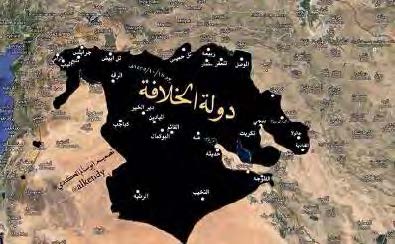
The ISIS self-declared (June 2014) Caliphate State ISIS in large areas of western Iraq and eastern and northern Syria. The map was posted on jihadi forums on August 18, 2014 (Alplatformmedia.com; Hanein.info).

Left: Map of the Islamic Caliphate in English with a picture of Abu Bakr al-Baghdadi at the right (Hanein.info). Right: The Islamic Caliphate State with its extensive borders. Only Islamic names appear on the map, not the names of the modern nation states (Hanein.info).
The Caliphate in Islamic history[18]
Reestablishing the Islamic Caliphate is the vision of the Salafist-jihadi movement, which ISIS has begun to put into practice. Various Islamic factions, entities and activists (for example, Hizb ut-Tahrir, the Party of [Islamic] Liberation, founded in 1953) and Islamic thinkers championed the concept of reestablishing the Caliphate. Some of them (such as Abdullah Azzam, Osama bin Laden’s mentor) even attempted to chart a path to its establishment. For Salafist-jihadists, the establishment of the Caliphate means subjecting all Muslims to a single accepted and agreed-on ruler, eliminating nation states (the fruit of the “imperialist plot”), eliminating the “infidel regimes” in Arab and Muslim countries and establishing a single Muslim theocracy. The theocracy will be governed in accordance with the model of the Islamic Caliphate in its Golden Age, (i.e., the generations after the Prophet Muhammad) according to the radical Salafist-Jihadi interpretation of Islam, and will be headed by a single ruler, the Caliph.
The Caliphate vision is inspired by the period following the death of Muhammad (632 AD), when it was necessary to appoint his substitute (a successor was not appointed because no mortal could not succeed him). The Arabic title given to the rulers who came after Muhammad was Khalifat Rasul Allah, i.e., “substitute for the messenger of Allah” or, in its short form, Caliph (“substitute”).
The period of the first four Caliphs of Islam, Abu Bakr (whose name was adopted by Abu Bakr al-Baghdadi), Umar, Uthman and Ali (632-661), was the most politically cohesive period in the history of Islam and is considered its Golden Age. They were the four Caliphs who established the first Islamic state, conducted the major conquests beyond its borders and laid the economic and administrative foundations for the Muslim Empire. Within a few generations, Muslim Arabs, who were unknown in the history of the world until then, established a huge empire on which they imposed the Arabic language and the religion of Islam.
For those reasons the first four Caliphs have been greatly admired in Islam throughout the ages, and many Sunni Muslim movements perceive them as their spiritual fathers. The collective term for the first four Caliphs is Rashidun, i.e., those who follow the straight path as instructed by Muhammad. The institution of the Caliphate has since become a foundation of Islam, and Caliphs from the Quraysh tribe (Muhammad’s tribe) ruled it in practice until the time of the Ottoman Turks (1517). They were replaced by Ottoman-Turkish Caliphs, who gave themselves the director title of Sultan. They ruled until 1924, when Turkey, which became a republic under the leadership of Atatürk, announced the abolition of the Caliphate.
As to the justification for idealizing the Caliphate justified, while the period of the first four Caliphs is considered by many Muslims as Islam’s Golden Age, an examination shows the idealization to be exaggerated: three of the first Caliphs were murdered and during their reign the weakness of Islam was revealed, i.e., its lack of unity and its inability to prevent civil war (fitna) and bloodshed. Shortly after the rise of the Abbasid rule (750 AD), the institution of the Caliphate began to gradually decline. When the Abbasid Empire began to disintegrate at the end of the ninth century AD, local rulers declared themselves Caliphs to legitimize their rule, and the institution of the Caliphate was gradually emptied of content.
Annulling the existence of the nation states in the Middle East
Islam, from its inception until the end of the First World War, did not recognize national borders in the territorial areas that it ruled under various dynasties (until the end of the Ottoman Dynasty). Nation states in the Middle East were created only from the beginning of the twentieth century after the First World War. ISIS does not recognize nation-state legitimacy or the national borders of the Middle East as outlined in the Sykes-Picot Agreement and formulated by the superpowers during and after the First World War.
For example, in a video distributed by Abu Bakr al-Baghdadi in January 2014, he objected to the political boundaries of the regional nation-states and stressed that ISIS intended to establish an Islamic state with no national boundaries. He described the Islamic state based on regions occupied by ISIS as “A country whose way was paved by Abu Musab al-Zarqawi [who founded Al-Qaeda’s branch in Iraq], and has absorbed the blood of our senior leaders Abu Omar al-Baghdadi [head of ISI until he was killed in a targeted attack] and Abu Hamza al-Muhajir [Abu Musab al-Zarqawi’s successor as the leader of Al-Qaeda’s branch in Iraq, who was killed in a targeted attack together with Abu Omar al-Baghdad].”
On June 29, 2014, ISIS posted a pair of videos (in English and in Arabic), expressing its ambition to annul the Sykes-Picot Agreement and “shatter” the borders of the nation-states established in the Middle East following it. The English-language video is entitled “The End of Sykes-Picot.” It includes a map showing the Iraq-Syria border and states that a single Islamic state with no national borders has now been established. According to the video a single supranational Muslim state will be established, to be headed by a single Caliph, Abu Bakr al-Baghdadi, who always says he breaks down barriers. The video adds that with the help of Allah, they will break down the barriers in Iraq, Jordan, Lebanon and in all countries, until they reach Jerusalem, with the help of Allah (Youtube.com).

Background slide of the audiotape posted on YouTube and elsewhere (June 29, 2014), entitled “The End of (the) Sykes-Picot (Agreement)”
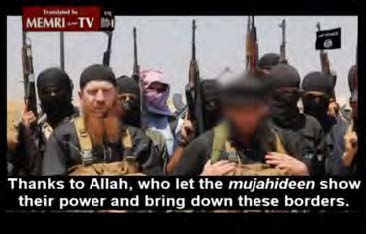
From a ceremony marking the “shattering of the borders” between Iraq and Syria, in a video posted by ISIS on June 29, 2014 (MEMRI, July 2, 2014)
The roots of ISIS’s hostility to the United States, the West and Western values
ISIS is intensely hostile to the United States, other Western countries, Israel and the values of the modern liberal West (democracy, pluralism, freedom of the individual, freedom of worship, equal rights for women, etc). Anti-Americanism and hostility to the West and its values are not unique to ISIS. It is one of the salient characteristics of radical Islam, in both its Sunni (Al-Qaeda) and its Shi’ite formats (Iran’s Khomeinist regime). The Al-Nusra Front, Al-Qaeda’s branch in Syria, is no different from ISIS in that respect. The source of their hostility to the United States is not only political. The depth of their hostility is reflected by a total rejection of American culture (the ultimate expression of modernity) and Western culture in general. This culture is perceived as a dangerous temptation threatening to poison the Islamic world. It is a temptation Muslims are liable to become addicted to and therefore is perceived as more dangerous.[19]
Like other organizations of its kind, ISIS is hostile to the United States and the West and is committed to waging jihad against them. ISIS has made that clear in many publications directed at the Western countries and through its actions, especially after the start of the American campaign against it (executing hostages and encouraging its supporters to carry out terrorist attacks against Western civilians worldwide). In practice, however, ISIS’s current top strategic priority is realizing the first stage of its vision, taking over Iraq and Syria and establishing the Caliphate State that has been set up in a significant portion of their territories.
The concept of takfir (denouncing a person as an infidel thereby enabling his execution) and its implications
Hezbollah leader Hassan Nasrallah frequently refers to Salafist-jihadi Islamic organizations (the most prominent of which are ISIS and the Al-Nusra Front) as “takfir groups” (jama‘at takfiriyya), i.e., groups that declare a Muslim or group of Muslims as infidels because they do not adopt the Sunni radical concept of Islam (as it is perceived by those who make the declaration). The declaration means “infidels” may be executed, so it is a serious accusation and permits the killing of individual people and groups. ISIS and similar Salafist-jihadi Islamist organizations translate the concept into executions and harassment of Shi’ites, Christians, Yazidi and members of other ethnic and religious communities.
The concept of takfir was previously used by Salafist-jihadi Islamist organizations such as Al-Takfir wal-Hijra in Egypt[20] and Al-Qaeda. However, the roots of ISIS’s extreme intolerance of Iraqi Shi’ites and minority groups can also be seen as the murderous legacy of Abu Musab al-Zarqawi, the founder of the Al-Qaeda branch in Iraq, from which ISIS emerged. Al-Zarqawi called for total war against the Shi’ites in Iraq and practiced on the ground. That is reflected by the indiscriminate, murderous terrorist attacks that have been carried out by ISIS and its predecessors in Iraq against Shi’ites and against other ethnic and religious groups, while damaging the burial sites and holy sites of the various religions.
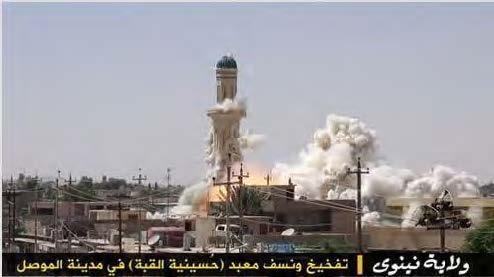
ISIS publication on behalf of the Nineveh province showing a Shi’ite mosque in the city of Mosul being blown up (Iraq.shafaqna.com)
Beginning the implementation of the vision: declaring the Islamic Caliphate
On June 29, 2014, ISIS spokesman Abu Muhammad al-Adnani declared the establishment of the Islamic Caliphate, headed by Caliph Abu Bakr al-Baghdadi. The announcement was made by a spokesman for ISIS on an audiotape posted to YouTube and elsewhere. On the occasion of the establishment of the Caliphate, Caliph al-Baghdadi announced an amnesty for detainees held by ISIS.

Background slide of al-Adnani’s audiotape entitled “This is the promise of Allah,” declaring the establishment of the Islamic Caliphate (YouTube)
Following are the highlights of the declaration of the Caliphate:
- Allah sent his messenger, the Prophet Muhammad, and ordered him to carry out jihad to ultimately establish an Islamic Caliphate. The nation is in a state of ignorance (jahiliyya, the period of ignorance that preceded Islam), and that is its situation is so deplorable. Allah has taken the Arab tribes and turned them into an Islamic nation and the time has come to renew its glory. There are signs of victory in battle and it is therefore essential to establish the Caliphate now.
- Thus the ISIS Shura Council (the supreme organ of the organization) was convened. It discussed the issue and decided to establish the Islamic Caliphate in the territories conquered by ISIS in Syria and Iraq (“from Aleppo to Diyala”). The Shura Council also decided to appoint Abu Bakr al-Baghdadi as Caliph and Imam of Muslims everywhere.[21] It was decided to change the organization‘s name from The Islamic State in Iraq and Greater Syria (ISIS) to The Islamic State (al-dawla al-islamiyya, IS).
- Abu Muhammad al-Adnani called on all operatives of Islamic organizations to swear allegiance (al-bay‘ah) to al-Baghdadi and work together to aid the Islamic State. The current residents of the Islamic State were the first called on to swear allegiance to al-Baghdadi. Al-Adnani warned Muslims against adopting Western ideologies such as democracy and nationalism, and called on all residents of the Islamic State to be united.

ISIS operatives in Al-Raqqa, ISIS’s “capital” in Syria, celebrating the declaration of the Islamic Caliphate (Al-Haq News Agency’s Twitter page, July 2, 2014)
Al-Baghdadi’s calls for jihad and his vision of the Islamic takeover of the world
ISIS emphasizes jihad as its chosen means to overthrow the regimes in Iraq and Syria, establish the Islamic Caliphate, and fight against its many internal and external enemies until the implementation of the vision, an Islamic takeover of the entire world (and symbolically, “the occupation of Rome,” the symbol of Christianity). That was reflected in the tape distributed by Abu Bakr al-Baghdadi shortly after the declaration of the Caliphate.
On July 1, 2014, Abu Bakr al-Baghdadi posted an audiotape in Arabic on YouTube entitled “Message to jihad fighters and the Islamic nation during Ramadan.” Al-Baghdadi took advantage of the Islamic religious month of Ramadan and the declaration of the Islamic Caliphate to encourage Muslim operatives around the world to support the Caliphate, join the ranks of the jihad fighters in Syria and Iraq and wage a jihad that would lead to an Islamic takeover of the world (according to MEMRI, translations of the audiotape were distributed in English, German, Russian, Albanian and French through the Al-Hayat Center, the ISIS propaganda unit).
The main points made by al-Baghdadi:
- Call for jihad: Al-Baghdadi called on Muslims to help the Islamic nation through jihad for the sake of Allah. He promised the jihad fighters that bliss awaited them in paradise and said, “Allah’s religion is the victorious one.” Al-Baghdadi added that the Muslim masses around the world lived in suffering, noting al-Sham (Greater Syria), Egypt, Iraq, Palestine [which is part of Greater Syria], the Arabian Peninsula, Tunisia, Libya, Algeria, Morocco, China, India, Somalia, the Caucasus, Afghanistan, Pakistan, the Philippines, Ahvaz (Khuzestan Province in Iran, with its Arab character). He said that the Muslims in those places were waiting for the Islamic State and jihad fighters to come and help them. He described the world as split into two camps: one included Muslims and jihad fighters; opposite it stood the camp of the Jews, the “Crusaders” (i.e., Christians) and their allies in all the “infidel countries,” led by the US and Russia.
- Praise for the Islamic Caliphate: Al-Baghdadi called on Muslims to support the Islamic Caliphate to save themselves from enslavement to foreigners. He noted that the Nation of Islam failed after the abolition of the Caliphate (1924) and was taken over by infidels. The infidels stole their resources, denied their rights, conquered their lands and appointed collaborators to rule over them by force. The collaborators waved false slogans of peace, democracy, pan-Arab nationalism, nation states and Ba’athism. In contrast, the Caliphate whose creation was declared “united the Caucasian, Indian, Chinese, American, Arab, French, German and Australian, who became brothers, defending each other in the same trench […] under one flag, the flag of faith.” He said that the Muslims would erode the power of the nation-state model, destroy the model of democracy and expose the “satanic nature” of those models.
- Defending ISIS’s methods: According to al-Baghdadi, what the Arab regimes call “terrorism” is actually resistance to their false slogans and implementation of Islamic religious law (sharia). He added “Is it not terrorism when Muslims are killed and their homes burned in Burma, when they are murdered and their limbs cut off in the Philippines, Kashmir, Indonesia, when they are deported in the Caucasus and buried in mass graves in Bosnia and Herzegovina? Is it not terrorism when the homes of Muslims in Palestine are destroyed, their land is stolen and their rights are violated? Is it not terrorism when mosques are burned in Egypt, the homes of Muslims are destroyed, their women are raped and the jihad fighters in Sinai and elsewhere are oppressed? […] Is what is happening in Turkestan[22] not terrorism? Is it not terrorism when women are prevented from wearing the hijab in France? […]” All this is not terrorism, but freedom and democracy, he added sarcastically.
- Call for Muslims to join the Caliphate which was established by the Islamic State in Iraq and Syria: Al-Baghdadi rejected the concept of the modern nation states and called on Muslims to join the Islamic State he founded. He said, “There is no [need for slogans such as] Syria for the Syrians or Iraq for the Iraqis, since the earth is Allah’s […] The country belongs to the Muslims; Therefore Muslims, wherever they are, immigrated to the countries of Islam, since the immigration to the area (or region) of the Islamic State [Dar al-Islam] is obligatory.” He called on Muslims who were able to do so to perform hijrah (i.e., migration, an important symbolic act in the history of Islam which, in his perspective, is related to the establishment of the Caliphate[23]). He called on Muslim clerics, led by sharia judges, people with military, administrative and academic capabilities, as well as Muslim doctors and engineers in all fields, to join his self-declared Islamic State, arguing that it was a necessity due to the sorry state of Muslims worldwide.
- The vision — the Islamic takeover of the entire world: Al-Baghdadi concluded by saying that if Muslims adhered to Islam they would rule the entire world: “If you cling to it [faith in Allah and the principles of Islam], you will even conquer Rome [the symbol of Christianity], and the Earth will be owned by you, with the help of Allah.”
Al-Baghdadi’s public appearance at the Great Mosque in Mosul (July 5, 2014)
On July 5, 2014, a video of a Friday sermon delivered by Abu Bakr al-Baghdadi at the Great Mosque in Mosul on the previous day was posted on YouTube. The video shows armed militants, apparently al-Baghdadi’s bodyguards, who were present in the mosque. His public appearance and the publication of his picture are unusual and are intended, in ITIC assessment, to dispel reports that appeared in the media at that time (from Iraqi government sources) about his having been injured in an air strike.
In the video, Abu Bakr al-Baghdadi is called by a number of Islamic titles: Caliph, Imam, and Amir al-Mu‘minin, which indicated that he headed the Islamic State. His main points:
- The importance of implementing Islamic law and the establishment of the Caliphate: “The religion of Allah will not exist, save through the implementation of sharia (Islamic law). Allah has a book which guides the Faithful [i.e., the Quran], and a victorious sword [for Islam].” He said that jihad fighters established the Caliphate and appointed an Imam (i.e., Abu Bakr al-Baghdadi himself) to rule over them. The establishment of the Caliphate, which was lost for centuries [although formally it was in existence until 1924], is the duty of the Muslims.
- The importance of the path of jihad: Jihad should continue for the sake of Allah despite all the difficulties, in order to fight idol worshippers: “Allah has commanded [you] to perform jihad through your property and through your souls […]” “He who performs jihad, Allah will forgive his sins and lead him through the gates of paradise.” Al-Baghdadi finished his sermon by asking Allah to grant victory to the Muslims and the jihad fighters.
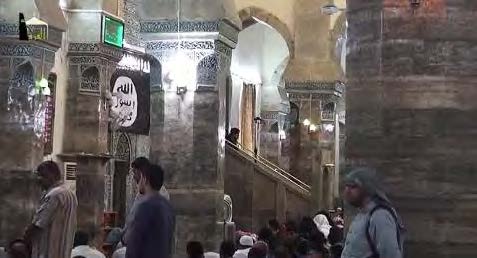
Left: ISIS flag. Right: An armed security guard during al-Baghdadi’s sermon at the Great Mosque in Mosul (YouTube, July 5, 2014)
The main purpose of al-Baghdadi’s rare public appearance was to refute media reports of his injury in an air strike. However, there is no doubt that his public appearance, where he was presented as a member of the Quraysh tribe, the tribe of the Prophet Muhammad, also served to establish the concept of the Caliphate, glorify al-Baghdadi’s status and legitimize his rule in the Muslim world. That was noted by his arch rival, Hezbollah leader Hassan Nasrallah, when asked why al-Baghdadi had appeared in the media (Al-Akhbar, Lebanon, August 15, 2014):
“It is not his policy to appear in the media, but I think he appeared in order to handle a problem of Islamic religious law. When ISIS presented its Caliphate, a dispute arose in the Islamic world between Sunni clerics, namely, how can we swear allegiance to a man whose name we do not know, whose personality we do not know, about whom we have no information or data. For one cannot swear allegiance to an unknown person, we must swear allegiance to someone known. He had to appear in order to become known and pave the way for the swearing of allegiance. That was the consideration behind the move […] Regarding his declaration that he is a member of the tribe of Quraysh — the Caliph must be a member of the tribe of Quraysh, while an Emir [ruler] of a country, like a king, prince or president, is not [considered] in the eyes [of his subjects] as a Caliph of the Muslims. The Caliph of the Muslims must be a member of the tribe of Quraysh. Because Abu Bakr al-Baghdadi’s project is the Caliphate, he must tell them that ‘I [i.e., al-Baghdadi] am a member of the tribe of Quraysh’ in order for their swearing of allegiance to be genuine”.
Initial responses to the declaration of the Islamic Caliphate
The establishment of the Caliphate State evoked a significant positive reaction among Salafist-jihadi Islamist organizations and operatives and among population groups in the Arab-Muslim world. However, it also encountered resistance. In retrospect, it can be said it served ISIS well, increased its ideological appeal, strengthened Abu Bakr al-Baghdadi’s position, and subsequently led to jihadi organizations and networks outside Iraq and Syria swearing allegiance to Al-Baghdadi.
The declaration of the Caliphate met with complete rejection among ISIS’s Sunni Muslim adversaries (mainly the Al-Nusra Front), Islamic rebel organizations in Syria, and Salafist-jihadi Islamist networks and individuals outside Iraq and Syria. For example:
- The Al-Nusra Front, Al-Qaeda’s branch in Syria, expressed its opposition to the declaration of the Caliphate and denied reports that it also planned to announce the establishment of an Islamic emirate. The organization issued an audiotape in which its leader, Abu Muhammad al-Julani, said he did not intend to establish an Islamic Caliphate at the present time, although his organization was striving for its establishment. In due time, Al-Julani noted, they would announce the establishment of an emirate, but it would be done with the consent of the jihad fighters and Muslim clerics (Longwarjournal.org, July 13, 2014).
- According to a Tweet that appeared on the Twitter account of the Islamic Front (a coalition of Islamic rebel organizations in Syria) on July 1, 2014, the declaration of the Caliphate was null and void for the following reasons: the conditions for the establishment of a Caliphate did not currently exist today, the message served an agenda that strived to divide Muslim countries into cantons at the expense of the Sunnis; regional and international entities would exploit the declaration to intervene directly in Muslim lands to thwart the revolutions in Syria and Iraq; and the Syrian regime might exploit the declaration to gain legitimacy in the eyes of the world to increase its activity against the “jihad fighters.” The announcement called the declaration of the Caliphate a fitna (civil war, a highly negative term in Islam) and called on all factions of jihadi organizations in Syria and Iraq to achieve “unity of line and unity of word.”
- Criticism of the declaration also came from a prominent Salafist-jihadi figure, Abu Muhammad al-Maqdisi (Isam Mohammad Tahir al-Barqawi), leader of the Salafist-jihadi movement in Jordan. Abu Muhammad al-Maqdisi, who is hostile to ISIS and opposes its actions, issued a statement on his Facebook page, stating that the declaration of the Caliphate threatened to divide the Muslims (Alghad.com, July 2, 2014). On another occasion, he said that he had been pressured to retract the statement he issued describing ISIS’s position as “deviant,” but he continued to adhere to his opinion (Al-Sabil, Jordan, July 1, 2014).
ISIS’s flag and its Islamic significance
The flag of Al-Qaeda and Salafist-jihadi Islamic organizations, including ISIS’s flag, are black with a white inscription of the Testimony (shahada), the heart of the Islamic faith: “There is no god but Allah.” Below the inscription there is a white circle, the seal of the Prophet Muhammad, and with an inscription in black reading “Muhammad the Messenger of Allah” (Muhammad Rasul Allah, an inscription that has to be read from the bottom up; See below). In some cases, the flag (prior to the declaration of the Caliphate) also included the inscription “The Islamic State in Iraq and al-Sham” to distinguish it from other jihadi flags.

Operatives carrying the ISIS flag, with an inscription on the bottom reading “The Islamic State in Iraq and al-Sham” (Assakina.com)
The flag used by ISIS is known by various names, among them “the oneness flag” (rayat al-tawhid),[24] “the flag of the Caliphate,” and is sometimes mistakenly called “the Flag of the Prophet.” In practice, the flags of the Salafist-jihadi organizations, including ISIS, are not identical to the flag of the Prophet. According to tradition, the flag of the Prophet is called “the banner of the eagle” (rayat aluqab) and looks different: the shahada on it appears in full on a horizontal line, as can be seen on the flags of most Islamist organizations.
The inscription “Muhammad, Messenger of Allah,” which appears inside the white circle, is read from the bottom up. According to Muslim tradition, the Prophet Muhammad adopted a silver seal containing three lines, with one word on each line: Muhammad, Messenger [of] Allah. In most traditions, the words, “Muhammad the Messenger of Allah” were written in the usual order, that is from top to bottom; according to some traditions, the lines are read from the bottom up, as in a seal. Since 2006, the Prophet’s seal has appeared on the flags of Salafist-jihadi Islamic organizations (affiliated with Al-Qaeda) with the lines going from the bottom up. The jihadi flag was adopted by ISI and later by ISIS.
ISIS has turned its jihadi flag into a brand, which it has marketed successfully around the world, including in the West. Being aware of the importance of the battle for hearts and minds, ISIS has made extensive use of its flag by its military forces and by the institutions of government it has established; the ISIS flag has been hoisted in central locations in the cities it controls and at the executions it has carried out. Arab and Western media, with their intensive coverage of ISIS, have made extensive use of the propaganda “raw materials” supplied to them by ISIS, contributing to the branding of the flag. Use of the flag and insignia quickly became a means to express defiance and/or support of ISIS in the Arab and Muslim world, in the West and in Israel (see below).
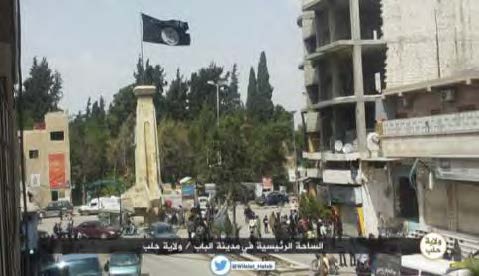
Hoisting the ISIS flag in the main square of the city of Al-Bab, in the Aleppo province, as a symbol of control and sovereignty (Sef.ps)
The Islamic roots of ISIS’s desecration of gravesites and shattering of statues
In the past year, the Arab and global media have given prominence to the desecration of graves and shattering of Muslim and non-Muslim statues by ISIS and Al-Nusra Front operatives in Syria and Iraq. That behavior, which characterizes the conduct of some of the Salafist-jihadi organizations (including Al-Qaeda), has historical Islamic roots attributed to a statement by the Prophet Muhammad.
From the outset Islam split into the Sunni school of thought (the majority version) and the Shi’ite school of thought (the minority version). Throughout Muslim history, the opposing sides periodically desecrated each other’s graves to highlight its own superiority. Acts of desecration were prominent at the beginning of the Sunni Abbasid Dynasty (in the 8th century) and the Safavid Shi’ite Dynasty (in the 16th century). Ibn Taymiyyah (died in 1328 AD) was a senior Sunni Muslim cleric who vehemently opposed the worshipping of graves of individuals considered holy. Ibn Taymiyyah, who possessed a Salafist Islamic worldview, forbade such worship because he saw it as an expression of polytheism, which Islam forbids, in view of the fundamental and uncompromising belief in the oneness of Allah (tawhid).
In the modern era, graves began to be desecrated with the rise of Wahhabism in the Arabian Peninsula during the 18th century AD. The founder of Wahhabism, Muhammad ibn Abd al-Wahhab (1691-1787), espoused highly conservative Sunni Islam (i.e., Salafism) and adopted Ibn Taymiyyah’s view regarding a complete ban on worshipping holy gravesites (including those of prominent Sunnis). He initiated an extensive campaign to desecrate holy gravesites in the Arabian Peninsula. Towards the end of the 18th century the Wahhabi Emirate was destroyed following a punitive campaign conducted by the son of the ruler of Egypt at the time, Muhammad Ali, as ordered by the Ottoman central government.
However, it was reestablished in the early 20th century following the renewed alliance between the Wahhabis and Emir Abdul Aziz Ibn Saud (who ruled from 1926 to 1953). The emir, who adopted the Wahhabi Islamic world view, was the actual founder of Saudi Arabia. After occupying most of the Arabian Peninsula, Ibn Saud began a holy gravesite cleansing campaign, primarily in the holy cities of Mecca and Medina. During the campaign the graves of family members and prominent friends of the Prophet Muhammad were also destroyed.
In the past two decades, following the rise of Al-Qaeda and additional Salafistjihadi organizations, graves have been desecrated and statues shattered in various locations around the world. Thus, for example, a huge statue of Buddha was destroyed by the Taliban in Bamiyan, Afghanistan, in 2001 (it was restored only a decade later); in 2012, Muslim cultural institutions were destroyed by Ansar Dine in Timbuktu, the capital of Mali in West Africa; and holy gravesites (mainly of Sufis) were desecrated by Islamist extremists in Libya in 2012 (not far from the capital Tripoli and in Misrata).
ISIS and the Al-Nusra Front continue the tradition of desecrating gravesites and shattering statues. That was evident in its recent conquests in Iraq in the summer of 2014. ISIS destroyed the grave of the Prophet Jonah in Mosul, the grave of the Prophet Daniel in the area of Mosul, and the grave of the Sufi Sheikh Ibrahim in the Nineveh province. In addition, ancient statues and cultural treasures in Iraq dating from the dawn of civilization were smashed:

The grave of the Prophet Jonah in Mosul before and after it was destroyed by ISIS (Alsumaria.tv; Allibad.net)
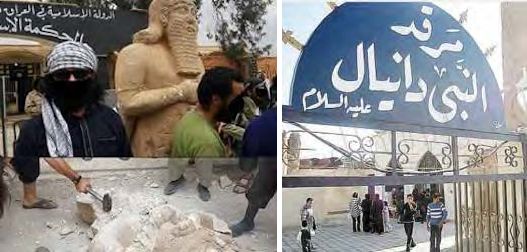
Left: The destruction of ancient statues in Iraq, cultural treasures dating from the dawn of civilization (Islamist-movements.com). Right: The grave of the Prophet Daniel in Mosul before it was blown up by ISIS (Youm7.com)

Left: The desecration of the grave of the Prophet Seth, the son of Adam, who is considered a prophet in Islam (abna.ir). Right: The grave of the Prophet Seth after its desecration (Room-alghadeer.net).
![]()
[1] Links to all other nine sections:
You can read the overview — “ISIS: Portrait of a Jihadi Terrorist Organization” — here.
You can read section 1 — “The historical roots and stages in the development of ISIS” — here.
You can read section 3 — “ISIS’s military achievements in Iraq in the summer of 2014 and the establishment of its governmental systems” — here.
You can read section 4 — “ISIS establishes itself in eastern and northern Syria” — here.
You can read section 5 — “ISIS’s capabilities: the number of its operatives, control system, military strength, leadership, allies and financial capabilities” — here.
You can read section 6 — “Exporting terrorism and subversion to the West and the Arab world” — here.
You can read section 7 — “ISIS’s propaganda machine” — here.
You can read section 8 — “The American campaign against ISIS” — here.
You can read section 9 — “ISIS response to the American campaign (update to mid-November 2014)” — here.
![]()
Notes:
[18] Based in part on Hava Lazarus-Yafeh, Chapters in the History of the Arabs and Islam [Hebrew] (Tel Aviv, Reshafim Publishing House, 1968), pp. 102-127.
[19] See Emmanuel Sivan, The Clash within Islam [Hebrew] (Tel Aviv, Am Oved / Ofakim Library, 2005), the chapter entitled: The Roots of anti-Americanism, pp. 57-65.
[20] Al-Takfir wal-Hijra carried out a wave of terrorist attacks in Egypt in the 1970s and early 1980s.
[21] In the Caliphate created after the death of the Prophet Muhammad in 632 AD, the Muslim Caliph also bore the title of imam. In Prof. Hava Lazarus-Yafeh’s book, Prof. Moshe Sharon writes: “The role of the Caliph was therefore an entirely practical and secular role. He had no spiritual advantages or spiritual powers that ordinary Muslims did not have. Nevertheless, his position was cloaked in a religious aura, by its very creation. Thus, for example, he bore the title of Imam (a title that was later used for Caliph as well), i.e., the leader of public prayer, thus he could, if he wished, lead the prayer ceremony and deliver the Friday khutbah (sermon) …” (Moshe Sharon, Chapter V: The Caliphate, in Hava Lazarus-Yafeh’, p. 125).
[22] Turkestan is the Sunni Muslim separatist name for the autonomous region of Xinjiang in western China where the Uighur people live. Uighur operatives have joined the ranks of jihadi organizations in Syria.
[23] Hijrah — The journey of the Prophet Muhammad and his first followers from Mecca to Medina in 622 AD, due to the persecution that they were subject to in the beginning. It has become a symbol of the isolation of loyal believers from the sinful and perverted society and as a model for the beginning of a proper Islamic society and the revival of Islam (Uriah Furman, Islamiyun [Hebrew]. Tel Aviv: IDF / Maarakhot Publishing House, 2002, p. 322).
[24] The flag is called “the oneness flag” (Oneness of Allah), because it contains the word of oneness (kalimat al-tawheed): “There is no god but Allah; Muhammad [is] the Messenger of Allah.”



 RSS
RSS


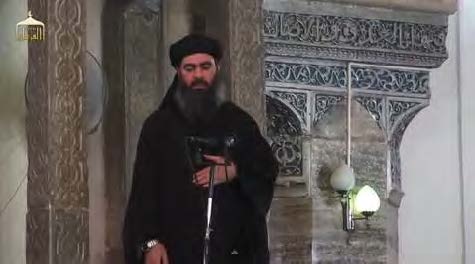
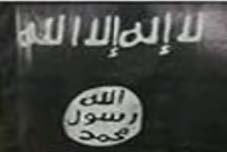
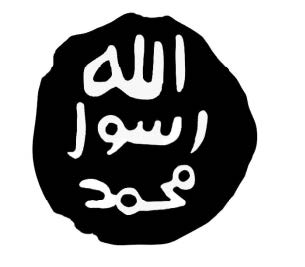
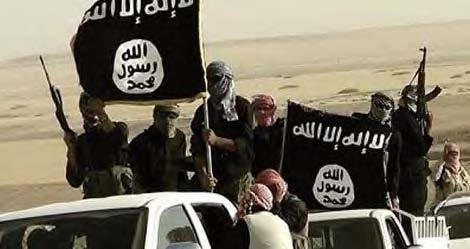




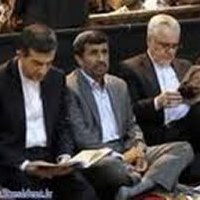




Latest Comments
Hello Mike, Thank you for your positive feedback to the article. I felt there wasn’t too much critical analysis of ...
Thanks for this considered and well constructed article. A follow up article on the manner in which the editorial contro...
THE CLUELESSNESS OF CLAIMING THAT OBAMA'S MIDDLE EAST POLICIES WERE A FAILURE CANNOT BE FURTHER FROM THE TRUTH, WHAT THE...
As long as Obama is the president of the usa do not trust the us government......
Thank you for an good read....